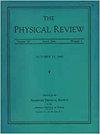H++H -和H(1
引用次数: 0
摘要
从理论上研究了${\ mathm {H}}^{+}+{\ mathm {H}}^{\ensuremath{-}}$和$\ mathm {H}(1s)+\ mathm {H}(ns)$与$n=2,3,4$碰撞时的结合电离。从头计算了相关的绝热势曲线和非绝热耦合,并考虑了${}^{1}{\ mathm {\ensuremath{\Sigma}} _{g/u}^{+}$和${}}^{3}{\ mathm {\ensuremath{\Sigma}} _{g/u}^{+}$对称性中最低电子共振态的自电离。通过求解包含复势矩阵的耦合Schr\ odinger方程,得到了严格非绝热表示的截面。研究了使用非局域自离描述的重要性。还研究了氢的不同同位素的缔合电离。计算截面与实测结果进行了比较。 本文章由计算机程序翻译,如有差异,请以英文原文为准。
Associative ionization in collisions of H++H− and H(1
Associative ionization in collisions of ${\mathrm{H}}^{+}+{\mathrm{H}}^{\ensuremath{-}}$ as well as $\mathrm{H}(1s)+\mathrm{H}(ns)$ with $n=2,3,4$ is studied theoretically. Relevant adiabatic potential curves and nonadiabatic couplings are calculated ab initio and the autoionization from the lowest electronic resonant states in the ${}^{1}{\mathrm{\ensuremath{\Sigma}}}_{g/u}^{+}$ and ${}^{3}{\mathrm{\ensuremath{\Sigma}}}_{g/u}^{+}$ symmetries are considered. The cross sections are obtained by solving the coupled Schr\"odinger equation, including a complex potential matrix, in a strict diabatic representation. The importance of using a nonlocal description of autoionization is investigated. Associative ionization is also studied for different isotopes of hydrogen. Calculated cross sections are compared with results from measurements.
求助全文
通过发布文献求助,成功后即可免费获取论文全文。
去求助
引用次数: 0
摘要
从理论上研究了${\ mathm {H}}^{+}+{\ mathm {H}}^{\ensuremath{-}}$和$\ mathm {H}(1s)+\ mathm {H}(ns)$与$n=2,3,4$碰撞时的结合电离。从头计算了相关的绝热势曲线和非绝热耦合,并考虑了${}^{1}{\ mathm {\ensuremath{\Sigma}} _{g/u}^{+}$和${}}^{3}{\ mathm {\ensuremath{\Sigma}} _{g/u}^{+}$对称性中最低电子共振态的自电离。通过求解包含复势矩阵的耦合Schr\ odinger方程,得到了严格非绝热表示的截面。研究了使用非局域自离描述的重要性。还研究了氢的不同同位素的缔合电离。计算截面与实测结果进行了比较。本文章由计算机程序翻译,如有差异,请以英文原文为准。
Associative ionization in collisions of H++H− and H(1
Associative ionization in collisions of ${\mathrm{H}}^{+}+{\mathrm{H}}^{\ensuremath{-}}$ as well as $\mathrm{H}(1s)+\mathrm{H}(ns)$ with $n=2,3,4$ is studied theoretically. Relevant adiabatic potential curves and nonadiabatic couplings are calculated ab initio and the autoionization from the lowest electronic resonant states in the ${}^{1}{\mathrm{\ensuremath{\Sigma}}}_{g/u}^{+}$ and ${}^{3}{\mathrm{\ensuremath{\Sigma}}}_{g/u}^{+}$ symmetries are considered. The cross sections are obtained by solving the coupled Schr\"odinger equation, including a complex potential matrix, in a strict diabatic representation. The importance of using a nonlocal description of autoionization is investigated. Associative ionization is also studied for different isotopes of hydrogen. Calculated cross sections are compared with results from measurements.
求助全文
通过发布文献求助,成功后即可免费获取论文全文。
去求助
联系我们:info@booksci.cn
Book学术提供免费学术资源搜索服务,方便国内外学者检索中英文文献。致力于提供最便捷和优质的服务体验。
Copyright © 2023 布克学术 All rights reserved.
京ICP备2023020795号-1
 京公网安备 11010802042870号
京公网安备 11010802042870号
京ICP备2023020795号-1

Book学术文献互助群
群 号:604180095


 求助内容:
求助内容: 应助结果提醒方式:
应助结果提醒方式:
